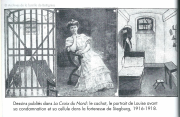Early Life↑
There was nothing to presage the important role played by Louise de Bettignies (1880-1918) in the Great War. She was born into a family of eight children, with grandparents of Belgian decent; she attended religious boarding school in Lille and the family passed on its strong sense of patriotism. A prolonged period of study in England introduced her to a more independent lifestyle. The death of her father led her to work as a governess for several important Central European families just prior to the war, notably for the family of Rupprecht, Crown Prince of Bavaria (1869-1955).
Becoming a spy↑
Upon her return in 1914, she was deeply affected by the invasion of Belgium and the north of France, like all inhabitants of Lille. She applauded the courage of the French soldiers and cared for the wounded. She decided to join her family who had sought refuge in unoccupied France and secretly took with her mail for the refugees. Her ship stopped in Folkestone, where her ability to speak English was noticed by the British secret service. She initially refused all collaboration, but she was then contacted by the French secret service which was in the process of organizing itself. Finally, as agreed with Major Walter Kirke (1877-1949), the man in charge of intelligence for the British high command, Louise returned to Lille after a short secret agent training course in London. As soon as she arrived, she was assigned the task of organizing the Ramble intelligence network with several Belgians already involved in the resistance. Louise was assisted in the spring of 1915 by Léonie Vanhoutte (1888-1967), a worker from Roubaix who had already helped Allied soldiers cross the border.
Her arrest and trial↑
The two women carried messages indicating German targets to destroy and about troop movement to an office of the British services in the Netherlands. They risked their lives travelling through occupied Belgium and across the electrified Dutch border. Spy networks were monitored with increasing caution, however, and Léonie was arrested in early September 1915, followed by Louise a few days later after being stopped in Froyennes, Belgium.
Imprisoned in Brussels, the ties between the two women were not immediately discovered, despite numerous interrogations. The truth came out, however, and the trial took place on 16 March 1916. Louise was sentenced to death and Léonie to fifteen years in a penal colony, thanks to the pleading in German given by Louise. Contacted by the family, the Spanish Embassy intervened and managed to obtain a life sentence for Louise on 21 March 1916.
A tragic end↑
The Siegburg penal colony opened the path to Louise’s death. She refused to paint the heads of grenades with her workshop comrades and was therefore sent to the dungeon in the middle of winter. She caught pleurisy but was treated and operated upon only on 18 April 1918, too late, most likely due to the director’s intentional neglect. On 28 July, she entered the hospital in Cologne where she died on 27 September, never having lost her faith in God or her country.
International recognition↑
Her tomb was found only in 1920 and the family obtained a state funeral in Lille. Louise posthumously received the War Cross and Legion of Honour. British authorities also gave decorations and admirable thanks to her mother in the name of the King for her contribution. In 1927, a statue of Louise was inaugurated in Lille with funding received from Marshal Ferdinand Foch’s (1851-1929) wife, Julie Bienvenue (1860-1950) and General Maxime Weygand (1867-1965)’s wife Marie-Renée-Joséphine de Forsanz (1876-1961). Official recognition of the heroism of women such as Louise de Bettignies and most members of the resistance networks was never given in order to quickly forget the tragic legacy of the war.
Chantal Antier, Magazine Guerres mondiales et Conflits contemporains
Section Editor: Emmanuel Debruyne
Translator: Jocelyne Serveau








